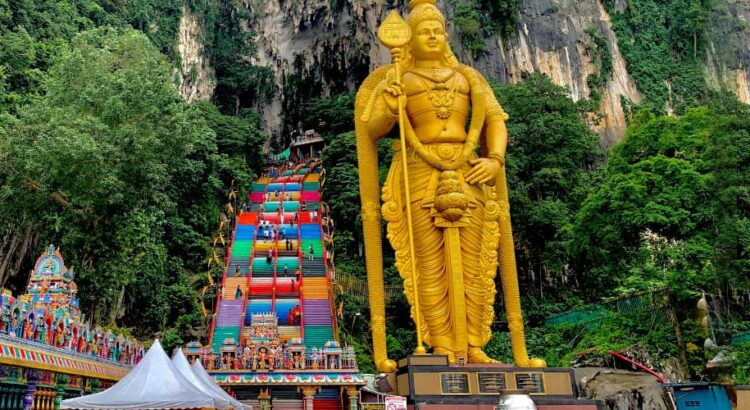Batu Caves is a Hindu temple and shrine located in Malaysia, specifically in the Gombak district of Selangor. The history of Batu Caves dates back to the late 1800s when the limestone hill where the temple is situated was first discovered by an American naturalist named William Hornaday. The temple was established in 1891 by K. Thamboosamy Pillai, a Hindu trader who dedicated the temple to Lord Murugan, the Hindu god of war.
According to legend, Lord Murugan once fought and defeated the demon Soorapadam, and Batu Caves is believed to be the site where this battle took place. The temple complex consists of three main caves and several smaller ones, and the main attraction is the Cathedral Cave, which is a large cavernous space with a high ceiling that is adorned with colorful Hindu statues and shrines.
The development of Batu Caves as a major Hindu pilgrimage site began in the early 20th century when the Indian community in Malaysia started to grow in size and influence. The temple has since become an important cultural and religious center for the Hindu community in Malaysia and is visited by thousands of devotees each year.
Batu Caves is also known for its annual Thaipusam festival, which is celebrated in January or February each year. The festival is marked by a colorful procession of devotees who carry kavadis (decorated wooden structures) and pierce their bodies with hooks and skewers as a form of penance. The festival is a major event in the Malaysian calendar and attracts visitors from around the world.
Today, Batu Caves is not only a place of worship but also a major tourist attraction, attracting visitors from all over the world who come to see the temple’s stunning architecture and religious art.
How to get here?
Batu Caves is a popular Hindu temple and tourist attraction located in Malaysia, specifically in the Gombak district of Selangor. Here are some ways to get to Batu Caves:
- By Train: Batu Caves is easily accessible by train, with regular services connecting the temple to Kuala Lumpur and other parts of Selangor. The nearest train station is the Batu Caves KTM station, which is located right next to the temple complex.
- By Bus: Batu Caves is also accessible by bus, with several services connecting the temple to Kuala Lumpur and other parts of Selangor. Buses usually stop at the Batu Caves Bus Station, which is a short walk from the temple complex.
- By Taxi or Ride-hailing Services: Taxis and ride-hailing services like Grab are also available in Kuala Lumpur and can take you directly to Batu Caves.
Things not to forget
It is important to note that Batu Caves can be quite crowded, especially during weekends and public holidays. Visitors are advised to wear comfortable shoes and clothing, as the temple complex involves climbing a steep flight of stairs to reach the main cave. It is also recommended to visit the temple in the morning to avoid the crowds and the heat of the day.
Image Credits: wikipedia.org
What is so special about Batu Caves?
Batu Caves, located near Kuala Lumpur, Malaysia, are renowned for their religious significance as Hindu temples, featuring a colossal Lord Murugan statue and a series of stunning cave temples. They also host the vibrant Thaipusam festival, offer striking natural limestone formations, and serve as a popular tourist and cultural destination.
What is the significance of Batu Caves in Malaysia?
Batu Caves in Malaysia are significant due to their role as a prominent Hindu religious site dedicated to Lord Murugan. They serve as a major pilgrimage destination, especially during the Thaipusam festival, attracting devotees and tourists alike. The caves hold cultural and religious importance for Malaysia’s Tamil Hindu community and are renowned for their striking cave temples and the colossal Lord Murugan statue at the entrance.
How much is entry to Batu Caves Malaysia?
As of my last knowledge update in September 2021, entry to Batu Caves in Malaysia was generally free. Visitors were allowed to enter the cave temples and explore the site without paying an entrance fee. However, there may have been fees associated with specific attractions within the Batu Caves complex, such as the Ramayana Cave or the Dark Cave, which are separate from the main cave temple.
Please note that circumstances can change, and it’s possible that there have been updates or changes in the entry fees or policies since my last update. To get the most accurate and up-to-date information on entry fees for Batu Caves, I recommend checking with local authorities or the official Batu Caves website if available.
What is inside Batu Caves?
Inside Batu Caves, you will find a combination of natural limestone caves and man-made Hindu temples and shrines. Here’s what you can expect to find inside Batu Caves:
- Cathedral Cave (Temple Cave): This is the largest and most famous of the caves at Batu Caves. It houses several Hindu shrines and temples dedicated to Lord Murugan and other deities. To reach this cave, you must climb a steep flight of 272 colorful steps, and the cave’s interior is adorned with religious statues and paintings.
- Art and Sculptures: The Cathedral Cave features various intricate sculptures and artwork depicting Hindu mythology and religious scenes. The cave’s interior is a blend of natural rock formations and man-made religious decorations.
- Golden Statue of Lord Murugan: At the entrance of Batu Caves stands a colossal golden statue of Lord Murugan, one of the tallest statues of a Hindu deity in the world. This statue is a prominent landmark and a symbol of Batu Caves.
- Other Caves: In addition to the Cathedral Cave, there are several smaller caves and chambers within the Batu Caves complex. These caves may also contain Hindu shrines and are worth exploring.
- Thaipusam Festival Decorations: If you visit during the Thaipusam festival, you will witness elaborate decorations, processions, and rituals as devotees gather to celebrate and fulfill their vows.
- Stunning Views: From the entrance of the caves, you can enjoy panoramic views of the surrounding area and the city of Kuala Lumpur in the distance.
- Dark Cave: While not part of the main temple complex, the Dark Cave is another attraction within the Batu Caves area. It is a conservation site and offers guided tours that provide insights into cave ecology, geology, and biodiversity.
Overall, Batu Caves offer a blend of natural beauty, religious significance, cultural richness, and architectural marvels, making them a fascinating and multifaceted destination to explore.





